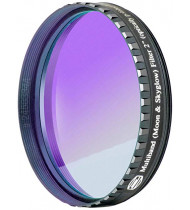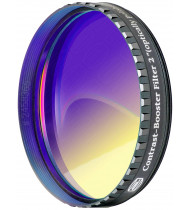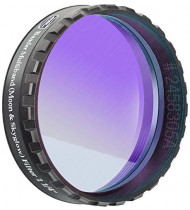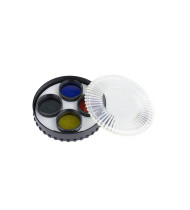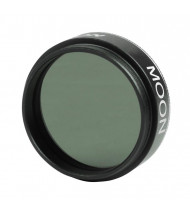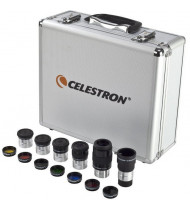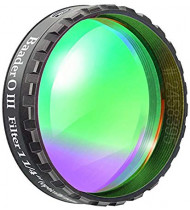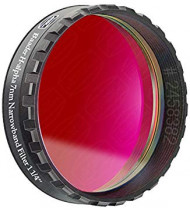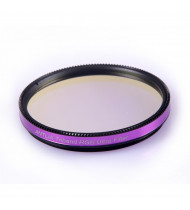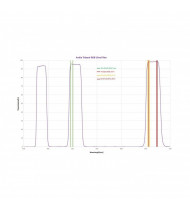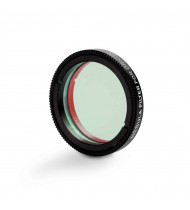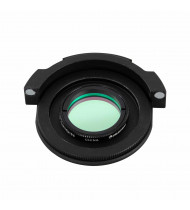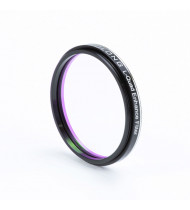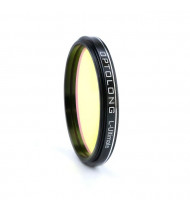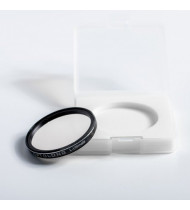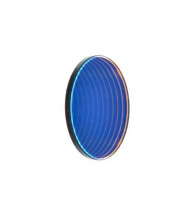
Baader Neodymium 2" (Moon & Skyglow)-Filter
US$ 127.17- The best visual and photographic filter for contrast enhancement for all telescopes, without loss of image brightness!
- The effect of the element neodymium as filter material is very impressive. When added to optical glass, it enhances contrast, enhances the red colour in the image (especially with Mars and Jupiter) and it darkens the spectral region which is particularly marked by street lamp light, which is the biggest contributor to the nightly "Skyglow".
- Planoptically polished and MC-coated – with IR-cut coatings!, without any loss of sharpness as a single filter in front of a binocular or be used for afocal projection with digital cameras (far from the focal point!)
- The IR spectral range is blocked making stars much sharper when used with dSLRs.
- 1¼" Contrast Booster Filter that completely eliminates false color
- Removes the bluish "hue" (=lack of contrast) during lunar, planetary, solar and terrestrial observation
- Boosts contrast and sharpness for fast achromatic telescopes - with over 95% transmission
- Planeoptically polished, non-ageing sealed coating edges
Baader Contrast Booster Filter 2" (50.8mm)
US$ 118.40- 1¼" Contrast Booster Filter that completely eliminates false color
- Removes the bluish "hue" (=lack of contrast) during lunar, planetary, solar and terrestrial observation
- Boosts contrast and sharpness for fast achromatic telescopes - with over 95% transmission
- Planeoptically polished, non-ageing sealed coating edges
- The best visual and photographic filter for contrast enhancement for all telescopes, without loss of image brightness!
- The effect of the element neodymium as filter material is very impressive. When added to optical glass, it enhances contrast, enhances the red colour in the image (especially with Mars and Jupiter) and it darkens the spectral region which is particularly marked by street lamp light, which is the biggest contributor to the nightly "Skyglow".
- Planoptically polished and MC-coated – with IR-cut coatings!, without any loss of sharpness as a single filter in front of a binocular or be used for afocal projection with digital cameras (far from the focal point!)
- The IR spectral range is blocked making stars much sharper when used with dSLRs.
- A nice beginner’s set of 1.25” planetary filters for any telescope.
- See features on the Moon & planets in a whole new light.
- The aluminum cell is threaded on top and bottom for stacking.
- Includes Wratten #12 Deep Yellow, #21 Orange, #80A Light Blue, and a #ND-96-0.3 Neutral Density Filter with 50% transmission.
Celestron Moon Filter 1.25" (31.8mm)
US$ 16.66Reduce glare and increase contrast of the Moon with the Celestron 1.25” Moon Filter. Also useful for extra bright planets as well as terrestrial viewing over sand or snow. Threads onto most 1.25” eyepieces in secondsCelestron Eyepiece and Filter Kit 1.25"
US$ 244.70Five quality Plossl eyepieces, a 2X Barlow Lens, six colored filters to improve observations of the planets, a Moon filter, and a foam-fitted aluminum carry case with extra room to grow- A customizable way to reduce brightness and glare on the brightest celestial objects like the Moon, Venus, and bright double stars
- Adjust the level of light transmission from 1-40% for the best possible view for your specific target and current viewing conditions
- Simple to use—just rotate filter’s lower ring to adjust brightness
- Threads onto any Celestron 1.25” eyepiece
Baader O-III Filter 1.25" (10nm) visual
US$ 83.32- ultra hard and bright O-III visual contrast for 6" and larger telescopes
- no visual color fringing, just pure O-III
- non-ageing sealed coating edges
Baader O-III Filter 2" (10nm) visual
US$ 144.71- ultra hard and bright O-III visual contrast for 6" and larger telescopes
- no visual color fringing, just pure O-III
- non-ageing sealed coating edges
- Premium grade H-alpha interline chip CCD-filter for fast optical systems f/10 to f/2.8
- IR-blocked
- NO halos, NO reflections, NO ghosting
- non-ageing sealed coating edges
- Premium grade H-alpha full frame chip CCD-filter for fast optical systems f/10 to f/2.8
- IR-blocked
- NO halos, NO reflections, NO ghosting
- non-ageing sealed coating edges
Baader H-alpha 35nm CCD Filter 2" (50.8mm)
US$ 127.17- Premium grade H-alpha interline chip CCD-filter for fast optical systems f/10 to f/2.8
- IR-blocked
- NO halos, NO reflections, NO ghosting
- non-ageing sealed coating edges
Antlia RGB Triband 2" Filter
US$ 227.16Anti-pollution filter effectively isolates the emission lines not only of emission nebulae but also of galaxies, clusters or globular clusters and reaches a maximum transmission of up to 97%.- Improve your view of nebulae with your Celestron Origin, especially from urban and suburban skies. This filter blocks light pollution, increases image contrast and darkens the sky background for sharper, more contrasted images.
- This filter transmits only the key Hα-Hβ-OIII wavelengths from emission nebulae, making their colors stand out from the dark background. It also blocks light pollution, allowing it to be used even from urban and suburban skies.
- Made for the Origin 6" RASA lens. Unlike similar filters with narrower bandwidths, this filter was specifically designed to work with the Origin's fast f/2.2 lens.
- Made of Schott glass with anti-reflective coatings, the surfaces of this filter are completely flat and free of defects.
Optolong L-QEF L-Quad Enhance Filter 2"
US$ 209.61L-QEF eliminates light pollution caused by mercury and sodium lamps and produces a broadband image with minimal color cast. This filter is broadband and suppresses wavelengths of light pollution. It is great for star clusters, dark and reflection nebulae, as well as galaxies in skies affected by light pollution.Optolong L-Ultimate 2" Filter
US$ 341.17The L-Ultimate filter is a practical solution for all amateurs who want to use their telescope from urban and sub-urban areasOptolong SII Filter 6.5nm 36mm
US$ 153.48Extra narrowband SII-CCD 6.5nm filter (Sulful II for CCD) is designed for nebula observation allowing 6.5nm bandwidth of light centered on a wavelength of 672nm through, and reducing the transmission of certain wavelengths of light, specifically those produced by artificial light including mercury vapor, and both high and low pressure sodium vapor lights and the unwanted natural light caused by neutral oxygen emission in our atmosphere (i.e. skyglow).


